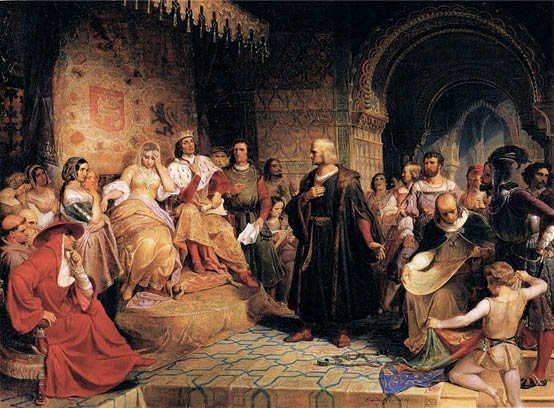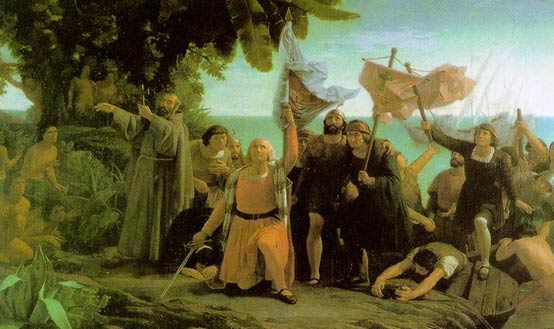
The Columbus Myth
The name Christopher Columbus is the Anglicization of the Latin Christophorus Columbus. His name in Italian is Cristoforo Colombo, and in Spanish Cristóbal Colón. The story of Columbus is not at all that we have been told. This article is not written to infer that Columbus did not travel to America; there is plenty of historical evidence to establish that fact. The chapter does, however, validate that by the time Columbus made his voyage, both North and South America had been explored surveyed and claimed by two separate European nations, and that Spain had knowledge of this fact. This chapter will also prove that Spain had plans to conquer Mesoamerica (Central America) even before Columbus began his voyage. Based on this information, the story that Cortez invaded Mesoamerica on his own, without permission from Spain is most likely not true.
The Quest for Support
In 1485 AD, Columbus presented his plans to John II, King of Portugal to cross the Atlantic. He proposed that the king equip three sturdy ships and grant Columbus one year's time to sail out into the Atlantic, search for a western route to the Orient, and return. Columbus also requested that he be made "Great Admiral of the Ocean", appointed governor of any and all lands he discovered, and given one-tenth of all revenue from those lands. The king submitted Columbus's proposal to his experts, who rejected it. It was their considered opinion that Columbus's estimation of a travel distance of 2,400 miles (3,860 km) was, in fact, far too low. The true reason for the denial was that Portugal did not want their colonies in South America discovered, until after the current war to reclaim the Iberian Peninsula from the Muslims was over. It is not a coincidence that Portuguese is the native language of Brazil.
In 1488 AD, Columbus appealed to the court of Portugal once again, and once again, John II invited him to an audience. King John again showed no interest in Columbus's far-fetched project. Columbus traveled from Portugal to both Genoa and Venice, but he did not receive encouragement from either. Columbus had also dispatched his brother Bartholomew to the court of Henry VII of England, to inquire whether the English crown might sponsor his expedition, but also without success.
Columbus then sought an audience with the monarchs Ferdinand II of Aragon and Isabella I of Castile, who had united many kingdoms in the Iberian Peninsula by marrying, and now, by ruling together. On 1 May 1486, Columbus received permission to see Queen Isabella. Columbus presented his plans to the Queen, who, in turn, referred it to a committee. After the passing of much time, the experts of Spain, like their counterparts in Portugal, replied that Columbus had grossly underestimated the distance to Asia. They pronounced the idea impractical and advised their Royal Highnesses to pass on the proposed venture.

‘Columbus Before the Queen’ (1843) by Emanuel Gottlieb Leutze. Image source: Wikipedia
However, to keep Columbus from taking his ideas elsewhere, the Spanish Monarchs gave him an annual allowance of 12,000 Maravedis and, in 1489 AD, furnished him with a letter ordering all cities and towns under their domain to provide him food and lodging at no cost. This was a full 6 years prior to the departure of Columbus for the “New World”. In reality this was a contingency plan by the Vatican, Spain and Portugal. They now knew that Columbus was very serious about crossing the Atlantic. If he was successful he would have discovered the Portuguese, Mayan, Aztec and Masonic colonies already in the Americas. The Portuguese and Spain needed a tactic to delay his departure until they had finished their war against the Moors (Muslims). Once the war was over they could divert their resources to protecting their interests in the Americas.
On January 2, 1492, the last Muslim leader, Muhammad XII, known as Boabdil to the Spanish, surrendered complete control of Granada, to Ferdinand and Isabella, Los Reyes Católicos ("The Catholic Monarchs"). The re-conquest (Reconquista) of Iberia was complete.
On the evening of August 3, 1492 AD, Columbus departed from Palos de la Frontera with three ships: a larger carrack, the Santa María (A Galician ship), and two smaller caravels, the Pinta (Meaning painted), and the Santa Clara, nicknamed the Niña (Meaning little girl) after her owner, Juan Niño of Moguer. The monarchs forced the Palos inhabitants to contribute to the expedition. The Santa María was owned by Juan de la Cosa and captained by Columbus. The Pinta and the Niña were piloted by the Pinzón brothers (Martín Alonso and Vicente Yáñez). The ship the Santa Maria was not only a Galician ship, owned by Juan de la Cosa, who after the voyage was responsible for printing the now famous map called the "Juan de la Cosa Map". The map was printed c1500 and shows 25 ancient geoglyphic survey markers that currently exist on the North and South American Continent. These geoglyphs would have taken centuries to explore and construct. Could both the North and South American Continents have been explored from coast to coast in the 8 years between the voyage of Columbus and the printing of the map? I think you already know the answer. (" Ancient Signposts" - Amazon.com, 2011)
The Pinzon Brothers
The Pinzón brothers were Spanish sailors, explorers and fishermen, natives of Palos de la Frontera, Huelva, Spain. All three were Marisco Muslims according to Christian scholar Jerald Dirks. Martín Alonso, Francisco Martín and Vicente Yañez Pinzon, participated in Christopher Columbus's first expedition to the New World and in other voyages of discovery and exploration in the late 15th and early 16th centuries.

Columbus and the Pinzón brothers arrive in America, Dióscoro Teófilo Puebla Tolín (1831-1901). Image source: Wikipedia
The brothers were sailors of great prestige along the previously held Muslim coast of Huelva. Huelva is located in Spain near the border with Portugal. Thanks to their many commercial voyages and voyages along the coast, they were famous, well off, and well respected in the maritime community. The strategic position of Huelva was established by the historic Atlantic port of Palos, from which expeditions had set forth to the African coasts as well as the wars against Portugal, organized on many occasions, by the Pinzon family.
Martín Alonso and Vicente Yáñez, captains of the caravels La Pinta and La Niña are the best known of the brothers, but the third brother, the lesser-known Francisco Martín, was aboard the Pinta as its master.
Although they sometimes quarreled with Columbus, on several occasions the Pinzón brothers were instrumental in preventing mutiny against him, particularly during the first voyage. On 6 October, Martín intervened, in a dispute between Columbus and his crew, by proposing an altered course (which Columbus eventually accepted) and thus calming the simmering unrest. A few days later, on the night of 9 October 1492 AD, the brothers were forced to intercede once again, and this time they proposed the compromise that if no land was sighted during the next three days, the expedition would return to Spain. On the third day, land was in fact sighted by Juan Rodriguez Bermejo (also known as Rodrigo de Triana). Could it be a coincidence that the Pinzon brothers knew exactly what correction to make in order to land on the first island outside the NE corner of the territory which Spain claimed on that first voyage?
The Pinzon brothers quickly set up survey markers to claim the Carribean, the Gulf of Mexico and Mesoamerica for Spain. Could it have been a coincidence that the Pinzon brother knew exactly when they would sight land? It is clear that either the Pinzon brothers, or Juan de la Cosa, had already been to the Americas many times. Juan being a Galician was most likely the one with the navigation knowledge to the Americas. This assumption is established in the book. Not only did Juan de la Cosa travel with many famous explorers, but his name implies that he may have had some secret navigation device that we no longer know about. People of that time were named after something peculiar to that person. Juan de la Cosa is Spanish for "John of the Thing". I have always wondered what "The Thing" referred to.
Why would the Monarchs of Spain, and the King of Portugal, choose two Muslim brothers to accompany Columbus to the Americas? After all, hadn't the two countries just spent 700 years getting rid of Muslim control and weren’t the Pinzon brothers the architects of wars against Portugal? The obvious answer is that they had many reasons to persecute the Pinzons, but instead used this, and the Pinzons knowledge of the Americas, against them in directing Columbus to the uncolonized and unclaimed parts of the Americas. (Actually, the Caribbean had already been claimed by the Mayans, as indicated by the Chichin Itza Pyramid geoglyphs, but that is another story.)
Part 2 – The First Voyage of Christopher Columbus
References
La Merica, Foundation Press, by Arthur Faram - 2013
Top image: ‘Landing of Columbus’ (1847), John Vanderlyn. Source: Wikipedia
By Arthur Faram
















Comments
His name in Spanish is not Colon. He was Catalan, not Castillian. The statue in Barcelona says Cristobal Colom.
Quite superficial and undocumented and even with wrong dates for Columbus presenting his plan to King John II. I suggest you peruse Manuel Rosa's article (End of the Enigmatic Christopher Columbus: A Man at Last Emerges to Eradicate the Myth) and study the evidence he presents in Columbus-The Untold Story
why post such hate? is it because you are simply a troll? if you were not actually a troll, and had any common sense or intelligence.... you would source this author's own site. where there is a treasure trove of actual documentation, with what seems like a life's worth of work and research. this man is onto decoding one hell of an amazing ancient supressed history.. and sorry troll's, anyone who knows anything knows that the roman catholic jesuits have been at war with, and supressing the masons for millenium.
Going to read part 2!
malisa wright
He's not going to do that, Carlos: look at his reply to me - you have to pay the man before you get the secrets! He is obviously so excited about discovering everyone who ever studied this before him was wrong that he forgot about those Masonic colonies. Or that he read somewhere that Rosslyn Chapel apparently has some Aloe Vera carved on a pillar somewhere, which is where most of the Masons in the Americas bunk comes from!
Pages